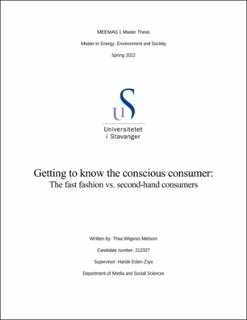| dc.contributor.advisor | Eslen-Ziya, Hande | |
| dc.contributor.author | Melsom, Thea Wigsnes | |
| dc.date.accessioned | 2022-09-30T15:51:19Z | |
| dc.date.available | 2022-09-30T15:51:19Z | |
| dc.date.issued | 2022 | |
| dc.identifier | no.uis:inspera:109900954:68476754 | |
| dc.identifier.uri | https://hdl.handle.net/11250/3022983 | |
| dc.description.abstract | The fashion industry is expected to emit 2791 million tons of CO2, consume 118 billion cubic meters of water and contribute to 148 million tons of textile waste by the year 2030 (Rausch & Kopplin, 2021). It is estimated that an average European consume 26 kg of textiles per year (European Environment Agency, 2019). In the European society it is becoming more known that the fashion industry is a great contributor to climate change and ethical concerns (Goworek et al., 2020; Niinimäki, 2010). Some consumers continue to buy fast fashion clothing, while others are more conscious and choose mainly second-hand. The goal of this thesis is to explore what differentiates the shopping practices between these two types of consumers: fast fashion and second-hand. The purpose is to discover whether the reasons provided by the second-hand consumers could be used to incentivize the fast fashion consumers to be more conscious.
The thesis is theoretically grounded on the Multi-Level Perspective (MLP) within transition theory (Geels, 2010, 2011, 2019; J. Köhler et al., 2019; Smith et al., 2010). In addition to responsible consumption theory (Agrawal & Gupta, 2018; Lim, 2017; J. A. Roberts, 1995) and the Not In My Back Yard (NIMBY) perspective as a conceptual tool when discussing the results (Dear, 1992; Feldman & Turner, 2010; Hermansson, 2007). A qualitative research method is applied, and both employees and consumers of fast fashion and second-hand clothing is interviewed. The results show that there are major differences in the two consumer groups, but also variances within each group. All of the participants were aware of over-consumption and to some degree that there are social and ethical issues with the industry. The main difference was whether this impacted their purchase intention or not. A uniformly suggested solution to the sustainable transition of the fast fashion industry were increased prices and more visible information. | |
| dc.description.abstract | The fashion industry is expected to emit 2791 million tons of CO2, consume 118 billion cubic meters of water and contribute to 148 million tons of textile waste by the year 2030 (Rausch & Kopplin, 2021). It is estimated that an average European consume 26 kg of textiles per year (European Environment Agency, 2019). In the European society it is becoming more known that the fashion industry is a great contributor to climate change and ethical concerns (Goworek et al., 2020; Niinimäki, 2010). Some consumers continue to buy fast fashion clothing, while others are more conscious and choose mainly second-hand. The goal of this thesis is to explore what differentiates the shopping practices between these two types of consumers: fast fashion and second-hand. The purpose is to discover whether the reasons provided by the second-hand consumers could be used to incentivize the fast fashion consumers to be more conscious.
The thesis is theoretically grounded on the Multi-Level Perspective (MLP) within transition theory (Geels, 2010, 2011, 2019; J. Köhler et al., 2019; Smith et al., 2010). In addition to responsible consumption theory (Agrawal & Gupta, 2018; Lim, 2017; J. A. Roberts, 1995) and the Not In My Back Yard (NIMBY) perspective as a conceptual tool when discussing the results (Dear, 1992; Feldman & Turner, 2010; Hermansson, 2007). A qualitative research method is applied, and both employees and consumers of fast fashion and second-hand clothing is interviewed. The results show that there are major differences in the two consumer groups, but also variances within each group. All of the participants were aware of over-consumption and to some degree that there are social and ethical issues with the industry. The main difference was whether this impacted their purchase intention or not. A uniformly suggested solution to the sustainable transition of the fast fashion industry were increased prices and more visible information. | |
| dc.language | eng | |
| dc.publisher | uis | |
| dc.title | Getting to know the conscious consumer: The fast fashion vs. second-hand consumers | |
| dc.type | Master thesis | |
